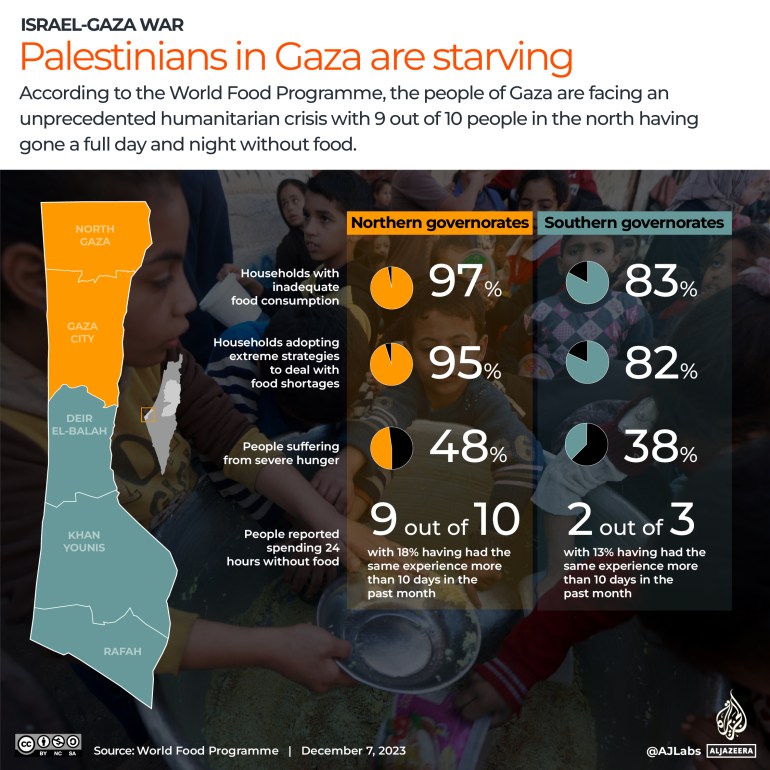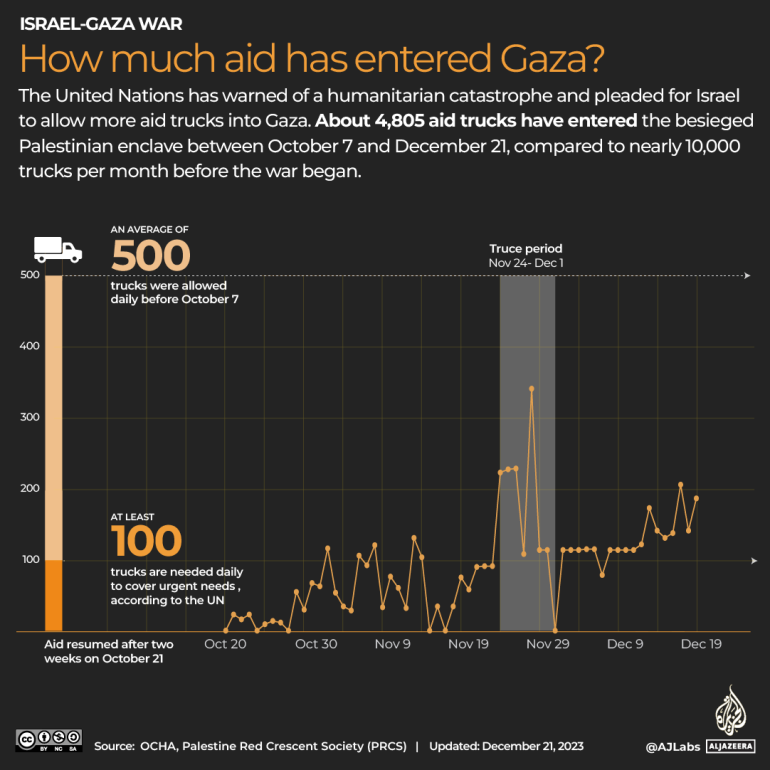
Weeks of restricted access to food in the Gaza Strip have had serious consequences Hunger and growing danger of famine in the besieged enclave.
There have been Israeli attacks throughout the Gaza Strip since the beginning of October damaged local bakeries and food warehouses as well as roads used to transport humanitarian aid. The total blockade of the enclave by Israel has also prevented access to food, water and fuel in the first place.
How bad is the hunger in Gaza and what has the food supply been like since the war? Here’s what we know.
What does the IPC report say about Gaza?
More than 90 percent of Gaza’s 2.3 million residents are affected by acute acute illnesses Food insecurityaccording to an Integrated Food Security Phase Classification (IPC) report on Monday.
The IPC, which measures hunger risks, also reported Thursday that 2.08 million people in Gaza face “acute food insecurity,” which can be classified at the organization’s risk level three or higher.
The IPC recognizes five phases of acute food insecurity, ranging from no phase (phase one) to disaster or famine (phase five). Phases three and five are considered crises and emergencies. “Acute” food insecurity is a short-term phenomenon and is usually due to unusual or man-made shocks, while “chronic” food insecurity is long-term in nature and is due to inadequate livelihoods.
Gaza’s entire population is expected to fall into phase three or higher between December and February, according to the United Nations-backed report.
If current hostilities and limited aid continue, Gaza is also at risk of famine in early February. The IPC definition of famine is when at least 20 percent of the population in an area falls into phase five of acute food insecurity.
What is access to food like in Gaza?
Families in Gaza have had to cope with deteriorating food quality and quantities, as well as being unable to prepare meals due to a lack of fuel.
It has become a habit not to eat for a day. In early December, the World Food Program (WFP) reported that nine out of 10 people across the enclave were skipping meals for extended periods of time.
Nutritionally vulnerable groups such as pregnant women are at increased risk baby food and milk are extremely scarce for young children who rely on it.
Even preparing meals requires finding alternatives to cooking gas, and in addition to using firewood or cardboard, at least 13 percent of displaced people are forced to burn solid waste, according to WFP.
Hunger has also increased rapidly since the end of a brief ceasefire in early December. Just twelve days after the end, the WFP found that at least half of the IDPs surveyed knew someone who had resorted to eating raw meat.
Access to water is also scarce, with less than two liters (0.5 gallons) available per person per day – far less than the 15 liters needed to survive, according to the WFP.

How much food aid is going to Gaza?
Since October 7, the number of food trucks entering Gaza in a month has fallen by more than half, compared to at least 10,000 trucks before the war.
During the two-month war, only 1,249 trucks carrying food aid reached the Gaza Strip, the WFP reported on December 6. The UN Office for the Coordination of Humanitarian Affairs also reported that in the first 70 days of the war, only 10 percent of the food needed was needed as Gaza’s entire population entered the enclave.
The WFP has recommended that at least 100 trucks carry food only and water About 1,000 trucks enter the Gaza Strip every day, but on most days since the war the total number of trucks entering has actually been lower. The agency also noted that damaged roads near Rafah on the border with Egypt – from where aid is now being distributed – cannot cope with this surge.
At the height of aid deliveries during the November 24-December 1 ceasefire, about 200 trucks arrived daily, while the WFP was only able to reach about 10 percent of Gaza’s population with in-kind and cash assistance.
Even after food aid was provided, access to sufficient quantities was not possible. A December 14 report by the Palestinian Center for Human Rights (PCHR) and Al Mezan, a human rights organization based in Gaza’s Jabalia refugee camp, found that people often wait in line for 10 hours near Rafah food distribution centers sometimes still came home empty-handed.
“I have to walk two miles to get a gallon [of water]Marwan, a 30-year-old Palestinian who fled south with his pregnant wife and two children on November 9, told Human Rights Watch. “And there is no food. When we find food, it’s canned goods. Not all of us eat well.”
Nevertheless, Gaza’s population relies primarily on humanitarian food aid, followed by local markets and help from friends or relatives. According to the WFP, as shortages in all of these areas increase, support from family members is also dwindling.
As more Gazans are pushed into shelters in southern governorates, which are also under heavy bombing, competition for food is expected to increase, the IPC said.

Can people in Gaza access food locally?
The fighting throughout the Gaza Strip and particularly in the northern governorates has made the situation particularly difficult access Food and help.
Local farmland, flour mills, bakeries and warehouses were also directly damaged by Israeli bombing.
Just a month after fighting broke out, all bakeries in northern Gaza were forced to close due to a lack of supplies such as flour and fuel, the UN reported on November 8. The threat of being hit by Israeli attacks also led to restrictions on movement for those wanting to leave their bakery houses for food.






Recent Comments